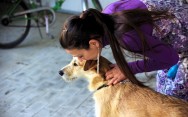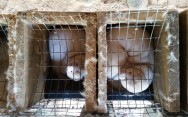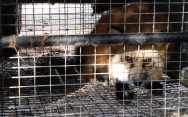Using hidden cameras in agricultural facilities is still one of the best ways to reveal the horrific cruelty of industrial agriculture. This is why states continue to pass “ag gag” laws to restrict and punish any exposure of practices at agricultural facilities.
An animal rights group, Mercy for Animals, used hidden surveillance to protest Senate Bill 16 in Kentucky, which aims to criminalize the use of recording equipment such as drones, cameras, video recorders, audio recorders etc. inside concentrated animal feeding operations. In doing so they exposed exactly the reason why criminalizing these practices shields violence and cruelty from the public eye.
Workers are known to abuse animals horribly at industrial agriculture facilities, and the farms that Mercy for Animals exposed were no exception. The group released videos showing workers kicking, stepping, throwing and stuffing chickens into cages for transport. The farms are described as contract farms providing chicken to Pilgrim’s Pride, one of the largest chicken producers in the United States.
Large industrial farms continue to claim that animals are killed humanely, and any problems are the result of bad apples. But the scale of cruelty and killing at these farms reveals that it is the norm for workers to dehumanize animals and abuse them before killing them. This is part of a psychological process that is not separate from industrial farming, it’s normalized by workers exposed to violence every day as part of their job. Animal rights groups continue to expose these conditions, and the farming groups protest that the problem is the individuals involved, and not the industrial scale of the killing operation itself.
One of the key tools animal rights activists have at their disposal is drones, which are cheap and capable of recording poor conditions, animal abuse and illegal hunting. Footage captured by drones has led to many successful campaigns on behalf of animals.
If blocking surveillance of animal rights abuses were just protecting private property, why is it that industrial farming interests are always behind these laws? The cruelty that we see on footage obtained by animal rights groups is clearly a fraction of what actually exists. We must continue to fight for the right to expose horrific cruelty and the lies of the industrial farming industry.
The question of whether it should be legal for people to rescue animals from slaughter houses and industrial farms is the subject of a recent New York Times op-ed.
It’s a question that deserves serious consideration. Animal activists have forced the public to confront these questions by filming conditions in slaughterhouses and industrial farms. Their reporting has revealed conditions of unimaginable horror and cruelty, and it has confronted us with our obligation not to be bystanders.
If you are aware of animal abuses committed at large agricultural facilities or slaughterhouses it’s not that simple to do something, however. If concerned citizens want to step in and rescue animals they can face serious charges. The NYT op-ed focuses on the actions of activists at DxE (Direct Action Everywhere) who have gained access to slaughterhouses and revealed abominable treatment of animals. In this case, the activists witnessed chickens at Foster Farms facility who were killed in violent haste. The activists’ infrared cameras showed live birds thrown, crushed and suffocated under piles of dead birds. Many weren’t stunned properly before being killed. There were other reports from U.S. Department of Agriculture inspectors of birds that had been dunked alive in a boiling water tank for defeathering. The activists rescued several animals from the plant, and there are other cases where activists have stepped in and rescued animals from industrial farming facilities and slaughterhouses.
The NYT op-ed made the point that if you saw someone boiling animals alive in your neighborhood, you would feel an obligation to step in and rescue the animals. Why is it any different at a Big Ag facility? There are laws that allow people to rescue dogs from hot cars, yet rescuing animals from cruel industrial farms is charged as theft, and filming the scenes of cruelty can be charged as criminal trespass.
Many of the activists say they are happy to stand trial to help set new precedents for animal rescue. This can pay off, such as in the case of a Utah jury who acquitted two activists of burglary and theft for taking two sick piglets from a Smithfield Farms facility.
This is just the beginning of a process that is stacked against Good Samaritans who want to rescue animals who are being treated cruelly. The bigger problem is that the industrial farming and meat industry will continue to commit cruelty as a matter of course. Industrial farming and the meat industry have sacrificed animal lives to the production line. Rescuing animals from these conditions is the first step towards making society confront what the appetite for industrially farmed meat means for animal lives.
|
Tags: Ag Gag,
Animal Abuse,
Animal Cruelty,
Animal Rescue,
animal rights,
Animal Rights Activists,
Chickens,
Factory Farming,
Kevin Boileau,
Nazarita Goldhammer,
Transhumanism








Social Media